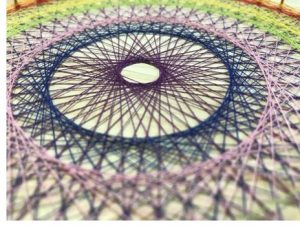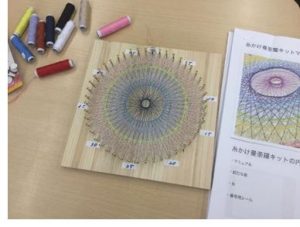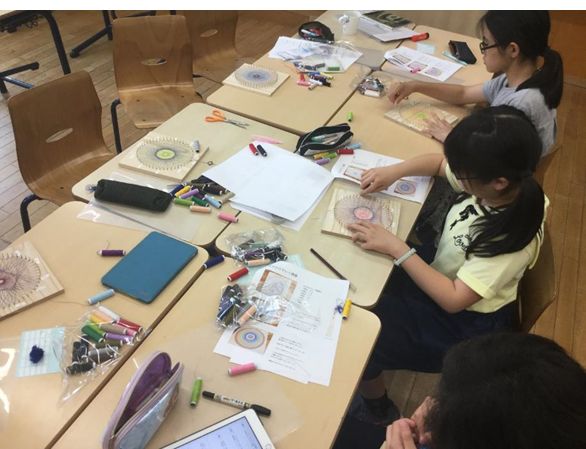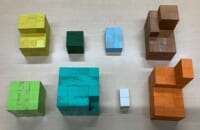本日10月9日を1009と4ケタの数で表すと、1009は素数です。西暦を含めた20181009は3×59×113×1009と素因数分解できるので、素数ではありません。
糸かけ曼荼羅は素数の性質を利用したデザインです。シュタイナー教育で使われたことが始まりとされています。(参考サイト:日本糸曼荼羅協会 https://www.itomandala.com/)
 板の上に円周上に釘を打ち、素数ごとに数色の糸をかけていくと、神秘的ですてきな作品ができ上がります。
板の上に円周上に釘を打ち、素数ごとに数色の糸をかけていくと、神秘的ですてきな作品ができ上がります。
今回は、48本のピンで作る方法を紹介します。まず23番目ごとに、時計回りに糸をかけていきます。糸はどのピンとも重複することなく、糸を最初にかけたピンに戻ってきます。その後、19、17、13、11、7、5番目ごとに糸をかけていきます。
これらの数が素数であること、正確には、48とこれらの数の最大公約数が1であることがポイントです。
 集中しないと糸をかける場所を間違えてしまいます。色の選択、順序は自由です。
集中しないと糸をかける場所を間違えてしまいます。色の選択、順序は自由です。
現在、中学2年生の亀井優快さんは、小学生のときに、自作の素敵な糸かけ曼荼羅を本校に寄贈してくださいました。彼の作品が数学1教室前の廊下に展示してあるので、ぜひご覧になってください。(数学科 園田)
 “String – Mandala” is a design that supplies the nature of prime numbers. It was started when it was used at Waldorf education. We can make mysterious lovely works using some kind of color threads on nails put around the circumstances on the board.
“String – Mandala” is a design that supplies the nature of prime numbers. It was started when it was used at Waldorf education. We can make mysterious lovely works using some kind of color threads on nails put around the circumstances on the board.
We will introduce how to make “String – Mandala” using 48 nails. First, we wind a thread clockwise at each 23rd nail. A thread goes back to the first nail not duplicating any nails. After that, we wind threads at each of the 19th, 17th, 13th, 11th, 7th, 5th nails.
It is important the numbers are prime numbers. Exactly, GCD between these numbers and 48 is 1. If we do not concentrate to work, we will mistake the point to put a thread. It is free to choice colors and orders of threads.
Kamei Yukai san (8th grade) donated self – made “Itokake – Mandala” to our school. We exhibit his work in the hallway before math classroom 1. Please check it.
by Tsuyoshi Sonoda (Math Dept.)




